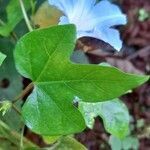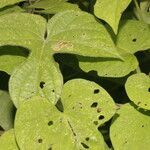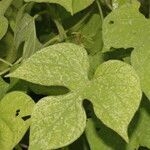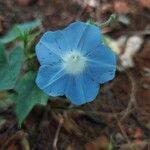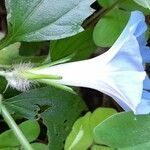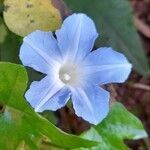Herbs annual, twining, with retrorsely hirsute axial parts. Stems 2-5 m. Petiole 2-15 cm; leaf blade broadly ovate or nearly circular, 4-15 X 4.5-14 cm, hirtellous, base cordate, margin entire or ± 3-(or 5)-lobed, apex acuminate. Inflorescences axillary, 1-to few flowered; peduncle 1.5-18.5 cm; bracts linear or filiform, 5-8 mm, spreading hirtellous. Pedicel 2-7 mm. Sepals lanceolate, ± equal, 1-2.5 cm, abaxially spreading hirsute, subglabrous apically, with a linear acumen, hairs swollen based. Corolla pale to bright blue with whitish tube, fading to pinkish in age, funnelform, 5-6(-8) cm, glabrous. Stamens included, unequal. Pistil included; ovary glabrous, 3-loculed. Stigma 3-lobed. Capsule straw colored, ovoid to ± globose, 8-10 mm in diam., glabrous. Seeds black, ovoid-trigonous, 5-6 mm, gray puberulent. 2n = 30*.
Herbaceous annual. Stems usually twining, with retrorse hairs on stems and petioles. Leaves ovate to orbicular in outline, apex acuminate, base broadly cordate, entire or 3-lobed; margin entire; both surfaces thinly to densely pubescent; 40-140 x 30-130 mm; petiole 30-160 mm long. Inflorescence a 1-to few-flowered umbellate cyme; peduncle hirsute, 20-120 mm long; bracteoles 5-10 mm long; pedicels 5-10 mm long, hairy. Sepals subequal, up to 35 mm in fruit, linear-lanceolate, apex long-attenuate, basal portion densely and patently hirsute. Corolla funnel-shaped, glabrous, 50-90 mm long, 40-70 mm wide, pale to bright blue turning purple or reddish magenta, rarely white, always paler outside. Capsule ovoid to globose, apiculate, glabrous, 8-15 mm long. Seeds up to 6.5-8.0 mm long, black, puberulous.
Vines with large trichomes, annual, densely to scattered pubescent throughout. Leaves ovate to suborbicular, 5-15 cm long, entire or 3 (-5)-lobed, basally cordate, the lobes apically acute to acuminate, pubescent. Flowers in 1-5-flowered, often dense cymose clusters of mature and developing buds and flowers, sepals long-lanceolate, 15-25 mm long, with linear-lanceolate apices, densely long-hirsute; corolla blue, purple or almost scarlet, throat often white, 3-5 cm long, the limb 4-5 cm broad. Fruits capsular, subglobose to globose, 8-12 mm in diameter; seeds pyriform, densely pubescent with short trichomes.
Annual; stems twining, bristly-pilose.. Leaf-blade ovate, about 8 cm. long and 8 cm. broad, cordate at the base, 3-lobed, ± adpressed pilose above and beneath; lobes ± acuminate at the apex; petiole bristly, about 4 cm. long.. Flowers solitary or in lax few-flowered cymes; peduncle 4–5 cm. long; pedicels up to 1.2 cm. long.. Sepals linear-lanceolate, 2.2–2.7 cm. long, 3.5 mm. wide at the base and 1.5–2 mm. wide above, long-attenuated at the apex, densely pilose with patent bristles at the base and with a few above together with much shorter pubescence.. Corolla magenta with paler tube, 6–7.5 cm. long.
Twining annual herb. Leaves ovate to circular in outline, 3-lobed, cordate at base; middle lobe ovate to oblong, acuminate; lateral ones obliquely ovate to broadly falcate, acuminate. Sepals linear-lanceolate, 23-28 mm long, long-attenuate at apex, basal part alone bristly. Corolla 55-70 mm long. Flowers magenta with paler tube.
Leaf lamina ovate to circular in outline, 3-lobed, up to 14 × 13·5 cm., cordate at the base, more or less appressed pilose above and beneath; middle lobe ovate to oblong, acuminate, lateral ones obliquely ovate to broadly falcate, acuminate; petiole up to 8 cm. long, bristly.
A climbing annual herb. The vines can be 5 m long. The stems are cylinder shaped and slender. The leaves are alternate. The leaves have 3 points. They are 3-8 cm long. The flowers can be blue, pink or red.
Flowers solitary or in lax few-flowered cymes; peduncle up to 7 cm. long, hirsute like the stems; bracteoles linear to filiform, 5–10 mm. long; pedicels up to 10 mm. long, retrorsely hairy.
Sepals linear-lanceolate, 2·3–2·8 cm. long, long-attenuated at the apex, densely pilose with patent bristles at the base and a few above together with much shorter pubescence.
The flowers pale blue in the morning turning bright pink or red-purple; with long narrow calyx-lobes
Corolla funnel-shaped, magenta with paler tube, 5·5–7 cm. long, glabrous.
The stems, etc., covered when young with spreading yellow hairs
Capsule ovoid to globose, glabrous.
Stems twining, bristly-pilose.
Ornamental herbaceous annual.
Seeds black, puberulous.
A twiner
